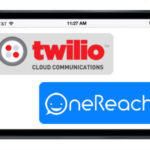
post
September 22, 2014
Texting Isn’t Just a One-Way Street
Appt. reminder: 10am w/ Dr. Redd @ Denver Metro Orthodontics.
Ever received a text like that? Chances are you have, but have you ever been able to text back and continue the conversation?
So far, a lot of businesses have been using texting for one-way marketing (promotional offers?) or reminder blasts. While this is great way to reach out to your customers, it’s not a great way to create a dialogue. Think about it: companies send an offer with a code, the customer texts it back, the company says thanks and that’s that. There’s no real personal relationship with the business, but that doesn’t mean there can’t be.
One way to get around this problem is to create automated responses. Most companies already have these on a small scale, like the thank you messages you get after accepting a text offer. However, these responses aren’t meant to carry on a conversation with the customer; they’re literally just there to say thanks (and nothing else).
While mass texts let customers know they’ve been heard, they don’t deliver on a personal scale. When you’re mass texting 500,000 people, getting to know each person isn’t a priority. When you do want to foster a relationship with your clients, you need to have more than just their phone number. You need their name.
According to science, people are more likely to open emails with their name in it. Text is a little different since you already have the contact name in your phone, but the same principle applies (after all, wouldn’t you rather see your name instead of “Valued Customer”?) Personalizing automated messages makes the customer feel more like they’re talking to a person and less to a machine.
But even automating texts and adding a personal touch doesn’t cover all the bases. Your business has been able to contact customers—can they contact you?
With platforms like OneReach, businesses can create automated text conversation flows that customers can use. This shift from one-way text messaging to two-way text messaging offers companies and customers a wider array of choices. If customers text in and need a new blender, they can choose from several options like replacing it or fixing it. Here’s a similar example:
One of the great things about automated responses is that customers can interact with the company at their convenience. Once they know their problem is being worked on, they don’t have to worry about waiting on hold or staying near the phone. They’re free to do other things.
Businesses can help customers go the extra mile with text chat, where customers can text a live agent (who answers from their computer) for help. Having the ability to chat with a live person ensures that the customer isn’t left hanging when there’s a problem they can’t solve. It also gives agents a chance to shine and share their expertise with customers, leading to a better relationship and perception of the overall brand.
One-way text messaging can get the job done, but it isn’t as personal or as powerful as two-way text messaging can be. Businesses wanting to engage customers on their preferred channel need to be able to send and receive messages—is your company one of them?
To learn more about two-way text flows, professionally designed or do-it-yourself, visit onereach.com.
Photo by Flickr user Geraint Rowland.
Stay up to date
Latest Articles




